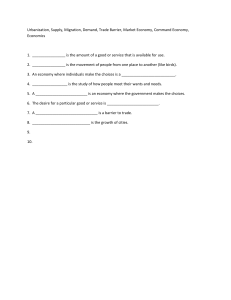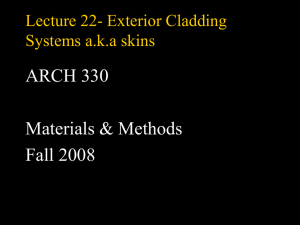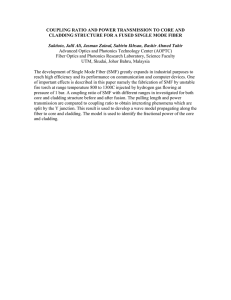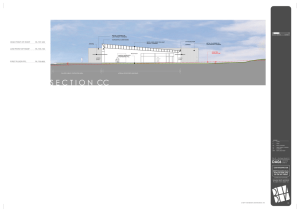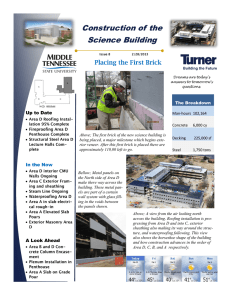Barrier vs. Rainscreen Exteriors: Design for Rain-Proof Facades
advertisement
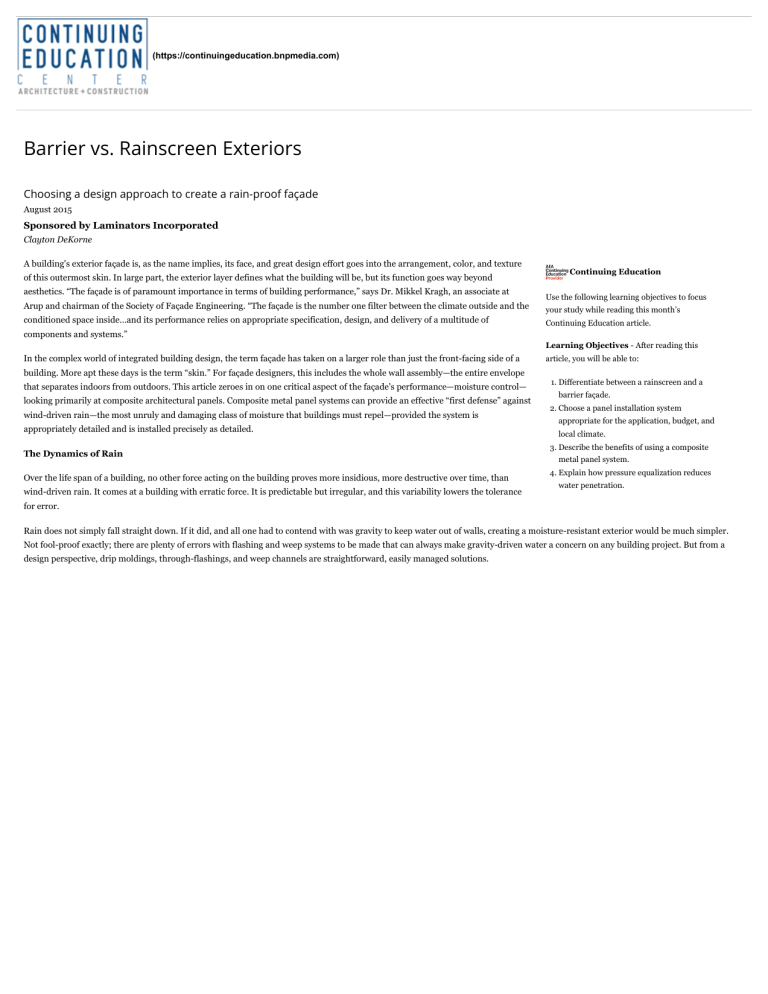
(https://continuingeducation.bnpmedia.com) Barrier vs. Rainscreen Exteriors Choosing a design approach to create a rain-proof façade August 2015 Sponsored by Laminators Incorporated Clayton DeKorne A building's exterior façade is, as the name implies, its face, and great design effort goes into the arrangement, color, and texture of this outermost skin. In large part, the exterior layer defines what the building will be, but its function goes way beyond aesthetics. “The façade is of paramount importance in terms of building performance,” says Dr. Mikkel Kragh, an associate at Arup and chairman of the Society of Façade Engineering. “The façade is the number one filter between the climate outside and the conditioned space inside…and its performance relies on appropriate specification, design, and delivery of a multitude of Continuing Education Use the following learning objectives to focus your study while reading this month’s Continuing Education article. components and systems.” Learning Objectives - After reading this In the complex world of integrated building design, the term façade has taken on a larger role than just the front-facing side of a article, you will be able to: building. More apt these days is the term “skin.” For façade designers, this includes the whole wall assembly—the entire envelope that separates indoors from outdoors. This article zeroes in on one critical aspect of the façade's performance—moisture control— looking primarily at composite architectural panels. Composite metal panel systems can provide an effective “first defense” against wind-driven rain—the most unruly and damaging class of moisture that buildings must repel—provided the system is appropriately detailed and is installed precisely as detailed. The Dynamics of Rain Over the life span of a building, no other force acting on the building proves more insidious, more destructive over time, than wind-driven rain. It comes at a building with erratic force. It is predictable but irregular, and this variability lowers the tolerance 1. Differentiate between a rainscreen and a barrier façade. 2. Choose a panel installation system appropriate for the application, budget, and local climate. 3. Describe the benefits of using a composite metal panel system. 4. Explain how pressure equalization reduces water penetration. for error. Rain does not simply fall straight down. If it did, and all one had to contend with was gravity to keep water out of walls, creating a moisture-resistant exterior would be much simpler. Not fool-proof exactly; there are plenty of errors with flashing and weep systems to be made that can always make gravity-driven water a concern on any building project. But from a design perspective, drip moldings, through-flashings, and weep channels are straightforward, easily managed solutions. A warm metallic finish and resistance to wind-driven rain are two essential ingredients for the exterior of the Lynnwood Convention Center, located on Puget Sound near Seattle. Photo courtesy of Laminators Inc. Similarly, capillary action—the movement of water caused by the surface tension between water drops—can be solved relatively easily with good design. The surface tension of water allows droplets to move together, or cohere. In porous materials, such as masonry, capillarity is usually the dominant force that causes wetting. Commonly known as “wicking,” water moves though masonry from one tiny pore to the next. The result is that the masonry stores this moisture, and, if enough mass is used, will have the capacity to hold enough water to prevent leaks through the wall. When the drying potential reverses (as happens when the sun comes out and warms the side of the building), the flow of water vapor reverses, explains Dr. John Straube of Building Science Corp. Masonry exteriors can be relatively forgiving, provided the mass is appropriate to the expected wetting conditions. However, metal or glass panels are another matter altogether. Metal and glass don't absorb any water, but capillarity remains a concern at joints, where very small crevices create channels that can move large amounts of water against gravity. The droplets, in an effort to cohere, will literally push themselves upward through crevices in the cladding, and if they move far enough along a crevice, water can penetrate the interior of the structure. One effective solution, that is often employed in some “dry seal” panel systems, is to create a capillary trap in the cladding joint—a gap that's large enough to break the surface tension so the water droplets no longer cohere. This gap needs to be drained so that when the surface tension is broken, the free-flowing water can drain away. A capillary trap, however, is ineffective when the penetrating water is driven by air pressures that forcibly push and pull water and air through crevices in the façade. Whenever you have a difference in pressure—known as a pressure gradient—across a surface, you have an engine that forcibly moves liquid, be it air or water (or both, in the case of a rain storm). This force always moves from a region of higher pressure to a region of lower pressure. In Providence, Rhode Island, which sees over 45 inches of rainfall a year, composite metal panels proved to be good choice for the Capital Cove condominium project. Photo courtesy of Laminators Inc. Pressure gradients occur frequently and come from many sources. Wind pressure is the dominant source. It is considered a dynamic pressure, because it is constantly changing in intensity and direction as it flows around objects. But there are also static pressures that can have an effect on air and moisture flow. These include: • Mechanical pressure. HVAC equipment inside the building can create positive and negative air pressures that act against the walls, pushing and pulling air through crevices that can draw water inwards or expel it to the exterior. • Stack pressure. The pressure flow caused by the buoyancy of heated air turns a tall building into a chimney. Air flows from the bottom to the top. At the top, positive pressure pushes air out of the lid. Near the bottom of the building, negative pressure pulls outdoor air inside. This same principle can occur in a narrow chamber, like the gap between a cladding material and inner wall assembly. Imagine a 1-inch gap behind a veneer cladding. If this gap rises unobstructed for the height of a tall building, stack effect would create a determined flow of air. It would have a powerful drying effect, but might also tend to pull rain and moist air in behind the cladding down low, and push it out at the top. Mechanical and stack pressures occur at fairly consistent and sustained levels, with only subtle variability in pressure. While these “static pressures” can move a lot of air through a building envelope when there are enough air leaks, the air pressures are relatively steady and can be effectively managed. Using impervious materials carefully installed to maintain air seals between layers of a wall assembly, the effect of static pressures on building airflow can be reduced to tolerable levels. Much more difficult to manage are the cyclic pressures induced by the wind. Wind pressure on a large building exerts pressure that flows in two directions. When wind is blowing—pushing at a building assembly—it is considered a positive pressure; when wind draws air away from an assembly, it is referred to as a negative pressure. Now add water. In a rain storm, water is both pushed and pulled by the wind. On a large building, some areas are more vulnerable than others, due to the prevailing pressures created by air flowing around the geometry of the building: As wind flows around corners, it accelerates, and eddies of air create a high degree of pressure fluctuation. Around the sides and top edges of the building, the air is moving faster, driving rain at a greater velocity against these parts of the wall. At the center of the building, the pressure will be fairly constant, resulting in a “cushion” of high-pressure air. This pressure will be positive (pushing against the building) on the windward side, and negative (drawing air away from the building) on the leeward side. Not as much rain reaches the building in this “dead spot” near the center as compared to the top and corners. On a tall building, 20 to 50 percent more rain wets the building at the top and corners than at the center area. However, some variability in wetting patterns will occur on multistory buildings. The taller and narrower the building, the more intense the potential for wetting will be. The more corners, bump-outs, parapets, and other differentiations in the building shape, the greater the chances of creating negative pressure flows that are capable of drawing water laterally and even upward through crevices in the façade. Designing a Greener Building While the all-glass façade may garner the praises of architectural critics and urban planners hoping for the next architectural splash on the city’s skyline, building performance can suffer. When glazing is overused, the thermal characteristics of glass, which is highly conductive and offers almost no resistance to heat flow, often result in a poor-performing building envelope. “From an energy standpoint, I have my doubts whether a building with floor-to-ceiling glazing on every floor can be a green building,” says building scientist John Straube. “Numerous studies have shown there are no daylighting or energy benefits with exteriors that have very high window-to-wall ratios.” A truly green building reduces energy loads while effectively managing exterior moisture, the bulk of which comes from wind-driven rain. Both energy and daylight performance benefit from a ratio of window-to-wall area between 25 and 40 percent, explains Straube. From a performance standpoint, a façade that combines opaque claddings with glazing will result in a greener building. Today’s design challenge is to make an architectural splash without resorting to simple aesthetics that compromise performance. The type of cladding material used on the building has a big impact as well. Porous masonry exteriors will absorb and hold a high percentage of the water that the building sees, and will release this moisture slowly over time by diffusion (the movement of moisture vapor through a building material by evaporation). On the other hand, with a non-porous cladding such as a glass curtain wall or composite metal panel system, most of the water striking the building will run down the face, and the chances for the wind to drive this water into joints will increase. This suggests that the joints in non-porous claddings will require extra attention, especially near building corners and near the top of the building. Detailing in these wetting areas will be critical to the building's ability to manage wind-driven rain. In most real-world cases, some degree of leakage is inevitable, and even the best, and most carefully installed cladding systems should have some capacity to manage water that penetrates the exterior skin. General Approaches to Keeping Water Out There are several approaches to keeping wind-driven rain out of walls: • Barrier systems attempt to stop all water at a single plane. Typically this plane is the outermost layer of the building envelope—the cladding, sometimes referred to as the outer “leaf.” To stop the water at a single plane, the joints between cladding members must be resistant to the penetration of driven rain over time. Barrier systems are sometimes referred to as “perfect systems” or “perfect walls” or “zero-tolerance wall systems” because the exterior layer must be a perfectly sealed plane. There is no forgiveness in the system, and if that plane leaks, there is typically no accommodation for the water that gets past it. These systems are also sometimes referred to as “face seal” systems. However, the term “face seal” should refer to the seal on the outer surface of a cladding joint. A face seal contrasts with a “drained seal,” “a concealed seal” or a “two-stage seal,” all of which refer to more durable methods of sealing a barrier system. • Drainable assemblies, often referred to as a “drained cavity wall” or “drained/back-ventilated (D/BV)” system, take into account that some moisture will be driven past the outer skin and allow this moisture to drain harmlessly away. The system consists of two layers separated by an air space. The outer layer is the cladding that sheds the majority of rain water. The inner layer is usually the exterior surface of the structure, and this surface must be protected by a weather barrier to shed any water that does get past the cladding. The air space between the two layers serves as a place for water to drain down to the appropriate base flashings. It also allows air to circulate behind the cladding. This “back ventilation” helps dry the wall by promoting evaporation. Note that a D/BV wall is sometimes called a “rainscreen,” particularly in residential applications. However, it's important to be precise with the term “rainscreen.” Here, the use of “rainscreen” is reserved for a pressure-equalized rainscreen (PER). • Pressure-equalized rainscreens don't rely on sealants at joints to keep water out. Instead the wall is designed with a series of pressurized compartments. These compartments usually consist of a drainage plane that is vented at the top and bottom and closed on the sides. When wind blows against the wall, the compartments fill with air. But because the sides are closed, and the airflow through the vents is limited, the compartments can only fill up until the air pressure matches the pressure of the incoming wind. At this point, the air inside the compartment essentially pushes back. When the wind subsides, the pressurized air in the compartments will flow out the vent until the pressure inside the compartment again matches the outside pressure. As long as the pressure on each side of the cladding is the same, there is no driving force for air and water to penetrate the cladding. Which approach is best for any given project largely depends on the type of materials chosen for the façade. In addition, this critical design decision will also be affected by other factors, not least of which are the project budget and the climate. To understand all the issues at stake, let's explore each system further. Barrier Systems In order for a barrier system to work, it's critical that the cladding material be impervious to moisture. If the cladding absorbs moisture, that moisture must be managed. A singleplane approach will not be feasible. In a barrier system, caulk and backer rod form the seal between two composite metal panels. Illustration courtesy of Laminators Inc. In addition, the joints between cladding members must be sealed, and that seal must be maintained over time. Any joint exposed to the elements will be more likely to shrink and crack over time, primarily due to the damaging effects of ultraviolet radiation from sunlight. Installation is critical. Face seals, in particular, must be executed with exacting care. Caulk beads need to conform closely to the profile, as depicted in the illustration on the following page. Just using backer rod is not enough. A misapplication as simple as too thick a bead of caulk, as shown in the illustration above, can result in premature failure of the seal. Also, to ensure a strong bond between the sealant and the cladding materials, surfaces and edges should be clean, dry, and free of all contaminants such as protective coatings, oils, grease, soap or detergent films, water, and dust. This doesn't happen on jobsites unless the installer takes great care. The correct shape for caulk is hour glass with a ratio of bond surface to mean thickness of about 4:1. If the backer rod is placed too deep, the caulk will be too thick, as shown in this illustration of incorrect caulk configuration. Illustrations courtesy of Canadian Precast/Prestressed Concrete Institute Thermal Expansion In regions with greater variability in climate conditions (cold or extremely cold winters and hot summers), the façade will see much greater variability in thermal movement, and sealants will tend to fail more quickly. When the temperature is cold, all of the materials on the façade contract and pull away from each other. When they heat up, they expand. With all façade materials, but especially metal panels that readily conduct heat, dimensions change as the material expands and contracts with fluctuations in temperature. This thermal movement must be taken into consideration. The amount of thermal movement needs to be calculated at the design phase, and the panel dimensions sized to limit the cumulative movement. Otherwise, when panels expand, they will push into each other, causing them to buckle and deform. As panels contract, the joints between panels will open up beyond what the sealant can tolerate. Thermal expansion is one factor that must be clearly understood when selecting an approach to keep water out of a wall system. In a harsh climate—either very cold or very wet—a barrier system may not be appropriate, regardless of the material. In less severe climates, thermal expansion still needs to be understood and carefully calculated when using metal panel systems. But as long as it is addressed at the design phase, it is completely manageable. Ultraviolet Radiation Even when panels are sized correctly to eliminate extreme dimensional changes that would cause these immediate failures, the panels still move back and forth. That's why sealants are flexible. But over time, the sealant dries out and hardens. Ultraviolet light breaks down the sealant chemicals, reducing its ability to absorb thermal movement, causing the sealant to crack and the bond to fail. All caulks, gaskets, and foam tapes are vulnerable to this eventual failure. Some last longer than others but eventually, if the sealant is directly exposed to sunlight, it will deteriorate. Concealed Joints With many manufactured systems, the joints are not simple face seals. With many composite metal panel systems, for example, many of the caulk joints are protected from direct exposure to the sun, making the system much more durable over time. As a government project, the Fort Knox Human Resource Center had to work within a limited budget and meet a minimum LEED Silver design certification. Photo courtesy of Laminators Inc. The edges of the composite metal panels used on the Ft. Knox Human Resource Center fit into extrusions (see bottom image), which protect the caulk used to seal the panels. Photo courtesy of Laminators Inc. Illustration courtesy of Laminators Inc. Typically, panels fit into extrusions or are covered by trim molding. This protects the sealant from exposure to ultraviolet light. This is a key feature. Because the metal panel itself is impervious to moisture, the joint is the only site for water entry. And because this joint is less vulnerable to installation error and the sealants are protected, a metal panel exterior can be a feasible barrier system. Two Types of Sealant Joints In this metal panel system, the caulk that seals the panel is protected by the J-extrusion. At the end of a run, however, a conventional face seal is required. Illustration courtesy of Laminators Inc. Indeed, it is possible that a barrier system may be the most appropriate option for a given project. There is a widespread belief that barrier systems are inferior in all cases. While it may be less forgiving to installation errors and climate extremes, in many situations a barrier system is the best option. The crucial elements are the cladding material and the seal between cladding members. Manufactured systems, in which the joints between cladding members are better controlled, have the best chances of performing well over time. Cost effectiveness is a primary reason for choosing a barrier approach. Since a single-plane barrier approach does not require installation of a separate weather barrier or detailing required to create an air space between the cladding and the structure, a barrier system is typically less costly to install. Assuming the project location is not in a severely cold or wet climate, and an impermeable material, such as a composite metal panel system is used, a barrier system may be a very practical solution. Drainable Assemblies The success of a drainable assembly largely relies on the integrity of the weather barrier behind the cladding. The weather barrier covering the “inner leaf” of the wall assembly must be shingled, so pieces installed higher on the wall overlap pieces installed lower on the wall. This way, water draining down the surface flows to the outside. In addition, the weather barrier must be flashed at the base and around all wall penetrations, and these flashings integrated “shingle fashion” to ensure that water does not get trapped in the wall. If the outer cladding is mostly airtight, this outer skin becomes the primary support for wind pressures. That means the air space between the cladding and the structure will be at a lower pressure. This imbalance can create suction pressures that draw wind-driven rain into the cavity, and the amount of water getting drawn in may exceed the ability of the system to drain adequately. This can be solved by venting the exterior cladding, and making the weather barrier airtight. This way, most of the wind pressures are born at the surface of the inner leaf, which now serves as the air barrier. The pressure gradient across the cladding will be reduced, reducing the possibility for water getting pulled in by air pressure. The airflow from the bottom vent to the top vent will also have a drying effect that further reduces the chances for a wet wall. This type of exterior works very well on a small building, and in residential applications, it is considered state-of the-art. But on a tall commercial building, there can still be problems created by pressure conditions in the airspace behind the cladding. When the wind pressure changes, as it will often, the air pressure in the cavity will not change fast enough and there will inevitably still be suction pressures that can draw large amounts of wind-driven rain past the cladding. What's needed is a more carefully controlled system that can maintain equal pressure on both sides of the cladding. Pressure-Equalized Rainscreens In a true pressure-equalized rainscreen (PER) wall, the joints between cladding panels are designed to minimize water penetration, but do not have to be sealed airtight. Air pressure within compartments in the cladding assembly keeps out the bulk of the water. Wind pressures are extremely dynamic forces, and the change can be abrupt and highly variable from one second to the next. Wind creates a very dynamic scenario, and under stormy conditions, no system will be able to perfectly maintain equal pressurization on both sides of the cladding at all times. In gusting wind conditions, the cavity pressure can at one moment exceed the outside pressure and the next moment, it can drop, drawing wind-driven rain inside. For this reason, a weather barrier and flashings are still imperative behind the cladding on the exterior of the inner leaf. These will ensure that any water that does get into the cavity drains down and away from the wall structure. In addition, the surface of the inner walls must be carefully detailed, as the air barrier on these walls will carry all of the wind pressures. The leakage area of the air barrier will also be a criterion for sizing the vents in the rainscreen compartments. (The rate of air flow through the vents must be roughly five times greater than the air leakage though the air barrier.) Dividing the cavity behind the cladding is necessary to prevent lateral airflows that would disrupt the ability to build sufficient pressure within the cavity. These compartments need to be sized to match the expected wind pressures. The mass of air (specifically, the volume of air relative to its temperature and humidity) that will be required to reach equalization is a function of the cavity volume. This affects the cavity size. The time to reach equalization depends on the rate at which air can enter the cavity, and this affects the size of the vent opening. Both cavity size and vent size must be calculated during design development to ensure that a particular façade design will perform as intended to keep water out. PER with Composite Metal Composite metal panel systems lend themselves particularly well to a PER wall. For starters, all of the theory of pressure equalization discussed so far assumes that the cladding is completely impervious to moisture. As soon as you introduce a porous cladding material into the mix, all bets are off. The air and moisture passing through a mass wall will completely change the pressure conditions within the cavity. In addition, metal panel systems lend themselves well to creating compartmentalized chambers. The panel dimensions will need to be limited, as previously mentioned, to control the amount of thermal expansion and contraction. These relatively small panel areas work well to create small compartments. Typically the panel extrusions are installed directly on structural sheathing with adhesive foam tape and screws (strapping is only required on gypsum sheathing, which does not have the strength to support the wind pressures by itself). The cavity is created by the panel profile, with the depth of the edge return built to match the volume required for the cavity. Anatomy of a Pressure-Equalized Rainscreen Metal panels, mounted on furring strips with foam tape, form the pressurized compartments. Vents in the bottom of the panels allow the compartments to fill with air when the wind blows. The air cannot escape out the sides of the compartments, so the air pressure essentially pushes back equally to the incoming wind pressure. Illustration courtesy of Laminators Inc. Dry-Seal System Last year, Chevrolet dealers across the country updated their dealership image, using bright-colored metal panels as part of the upgrades to both new and existing buildings in a range of climates. Photo courtesy of Laminators Inc. Composite Metal Panels The panels on a Chevrolet dealership are composed of a corrugated plastic core between two finished aluminum sheets, making them water-resistant and easy to maintain. Photo courtesy of Laminators Inc. Keeping Sight of the Whole While metal architectural panels can effectively repel wind-driven rain, one must remember that to accomplish this task, the exterior skin must function in concert with the other components that make-up the building envelope. As Dr. Straube explains, the entire envelope assembly chiefly provides environmental separation. Different components of that assembly fulfill a range of functions. To help conceptualize what the building envelope needs to be, he categorizes these functions into three types: • Support. The building envelope must resist or transfer loads placed upon it. This support function takes primacy. Without it, the other functions are meaningless. Wind loading is a big one here. The exterior skin is the first to “see” wind loads, and the exterior systems used here must be strong enough to not only withstand deformation caused by wind pressures, but also must be strong enough to transfer these live loads to other supporting components. In addition to wind, there are other structural loads placed on the exterior, including seismic, impact, other live and dead load forces, which also must be effectively transferred when the exterior skin is integrated with the building’s support-structure. • Control is a good way to think of the skin. Any cladding is first and foremost a “control layer,” argues Dr. Straube. It’s primary function is to control rain water. The entire envelope regulates other environmental elements, including water-vapor and air (both the good stuff that occupants breathe as well as airborne pollutants that should be avoided). In addition, control layers within the envelope assembly control the flow of energy, including heat, light, sound, and fire. When composite metal panels are used, these energy control functions are often not primary to the exterior skin. But the control of rain and ultraviolet light and shading, as well as the effect on air and water vapor flows, have significant impacts on subsequent control layers within the envelope that assume primary responsibility for controlling the flow of energy. One can’t completely disassociate the skin from energy control, even if the bulk of the insulation, fire stops, and vapor barriers are located elsewhere in the envelope assembly. • Finish. The finish of both the exterior and interior surfaces have an important aesthetic function. Performance here is optional from a physical standpoint, but while focusing on performance, one can’t forget that aesthetics often have primacy with building owners. Related to the finish, there is also a durability function that is often closely tied to the control functions. Control of ultraviolet light and impact resistance, for example, are two provisions that must be accounted for when selecting an architectural panel system. Evaluating Exterior Panel Systems If moisture protection was the only criteria, choosing an exterior panel system would be much simpler. However there is a wide range of other project considerations at hand, not least of which is the project budget. On any project, there will be a process in the design development stages when different systems will be evaluated on the basis of costs. During this process, architects will not only want to consider installed costs but also carefully evaluate the ongoing costs involved in the maintenance. Barrier systems will almost always be less expensive to purchase and install, but over the lifetime of a building will most likely be more expensive to maintain. The realities of development do not always take this long-term view into consideration, but architects should demonstrate this to the owners. If a barrier system is chosen for the project, keep these considerations in mind: • Quality control is essential. Implementation of panel alignments, fastener requirements and consistently detailed sealant joints will have an enormous impact on the durability of the system. • Pay close attention to wall drainage. Even though water is being managed at a single plane, make sure that water drains down and away from the building. • Maintenance costs will be higher, and tolerance for poor maintenance much lower. The architect should include a maintenance plan, so building owners are clear about their future obligations to maintain performance of the panel system • Climate conditions are key. Using a barrier system under low exposure conditions is fine; there is low risk. But projects in very cold or wet climates are not well suited to barrier systems. (http://www.laminatorsinc.com/) Celebrating its 50th anniversary this year, Laminators Incorporated is a leading manufacturer of a complete line of aluminum composite panels for the commercial construction industry. Laminators' lightweight substrates are exceptionally strong and durable, and available in a multitude of colors, finishes, and installation options to maximize the project design and budget. www.LaminatorsInc.com (http://www.laminatorsinc.com/) Originally published in Architectural Record
